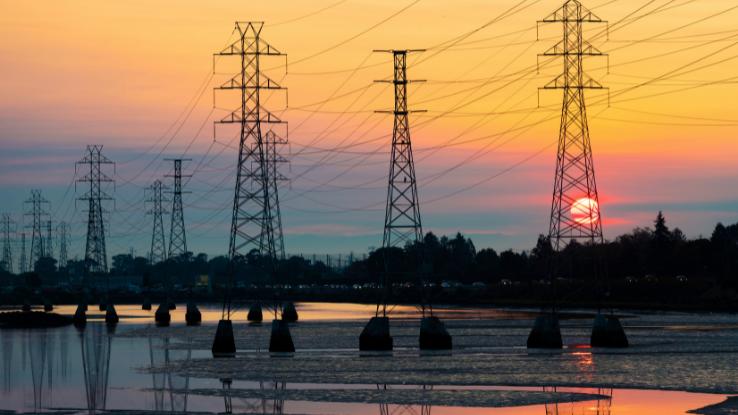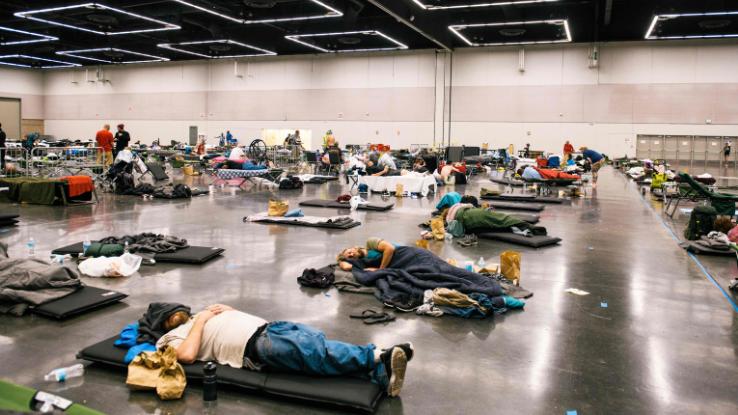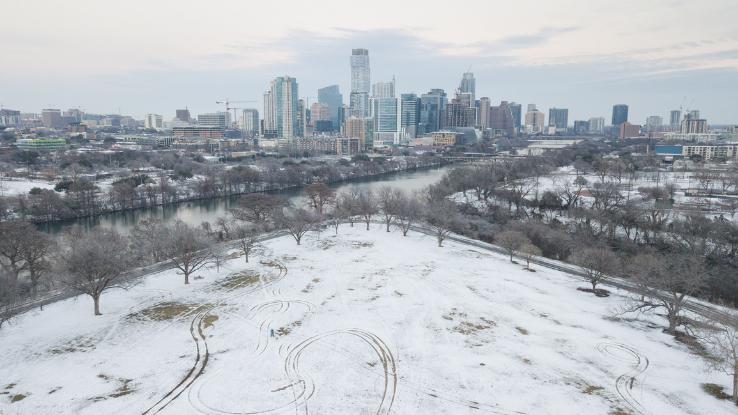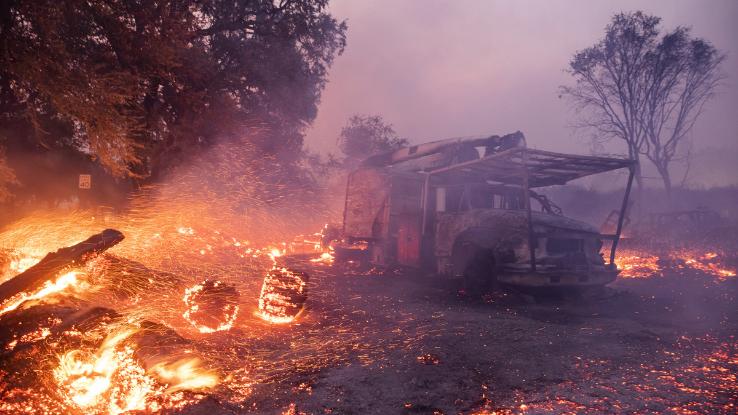The Politically Incorrect Guide to Climate Change Review

On the West Coast of the United states, many Americans find themselves preparing for "wildfire season" every year. And, in the past few years, the annual destruction has merely worsened. "Dissimilar hurricane seasons or monsoons, there is no single prescribed date for the first of the Due north American wildfire season," the Middle for Disaster Philanthropy notes.
With 75% of the Western U.Due south. — from the Midwest to the Pacific Ocean — Mexico, and Canada all suffering from what has been dubbed a "megadrought" (or at to the lowest degree the harbinger of one) by some, 2021'southward conditions are ripe for a challenging summertime. That is, experts fear that this yr's "fire flavor" may be even worse than 2020'due south tape-breaking wildfire flavour. Concluding year, four.3 meg acres burned in California; this year, AccuWeather 9.5 million acres across the western U.Southward. volition burn, which is "130% of the five-year average and 140% of the ten-twelvemonth boilerplate." Merely megadroughts and wildfires aren't the only catastrophes giving Americans intermission this summertime.
At the first of the season, the Pacific Northwest faced a tape-setting heat wave. "By all estimates, last week's rut moving ridge in the Pacific Northwest and British Columbia was essentially unprecedented," Matthew Cappucci writes for The Washington Post. "Seattle hitting 108 degrees, Portland spiked to 116 and Canada broke its national temperature record iii days in a row, hit 121 degrees on June 29."
The mortiferous estrus wave melted critical infrastructure, from ability cables to asphalt. Not to mention, cities like Portland and Seattle, known for their rain, cold and fog, aren't furnished with the same cooling infrastructure seen in typically warm cities in the U.S., which led to hundreds of heat-related deaths. As wildfire flavor begins, a heat dome also bears down on the tinderbox-like area. Fortunately, the link between crumbling (or ill-equipped) infrastructure and the climate crunch does seem to be on the federal authorities's radar — finally.
President Biden Addresses the Link Between the Climate Crisis & Failing Infrastructure
In May of 2021, President Joe Biden formally announced his desire to revamp the country'southward infrastructure in the course of a $ii trillion proposal. Known as the American Jobs Plan, the proposal aims to modernize public transit, bring bus and train service to areas that otherwise wouldn't accept access, and replace gasoline-powered vehicles with electric ones.
Moreover, the U.S. Department of Transportation (DoT) has estimated that the proposed plan would ameliorate "20,000 miles of roads and x,000 bridges" in addition to funding high-speed track service and making long-overdue repairs to existing public transportation. If the proposal is undertaken, the DoT feels that we will finally exist "addressing the inequities of our past transportation," and, in turn, the state will be "tackling the climate crisis."

The United nations (U.North.) has called climate modify the "defining crisis of our time." And it'south becoming increasingly clear that no state is immune to its impacts. "Rising temperatures are fueling environmental deposition, natural disasters, weather extremes, nutrient and water insecurity, economical disruption, disharmonize, and terrorism. Body of water levels are rising, the Arctic is melting, coral reefs are dying, oceans are acidifying, and forests are burning," the U.N. notes. "It is clear that business as usual is not good enough. Every bit the infinite toll of climate change reaches irreversible highs, now is the time for bold collective action."
From "Crumbling Infrastructure" to Tape-Setting Natural Disasters, This Is a Trouble Beyond the U.S.
The transit-related projects folded into the American Jobs Program are just a few of the examples of what Senator Elizabeth Warren (D-Mass.) has called "our crumbling infrastructure." As Senator Warren points out, there accept been decades of underinvestment — and a distinct lack of modernization. Of course, this notion extends to public buildings, private electrical grids and more.
And, frustratingly, every time a state, urban center or boondocks is hit by a devastating natural disaster or spate of unseasonal (and unexpected) atmospheric condition, this issue of crumbling infrastructure is brought to the forefront once again. When information technology snows in Texas, folks from winterized parts of the land find it comical that Texans aren't sure how to prep their homes. If a oestrus wave hits the San Francisco Bay Area, everyone is quick to joke that San Franciscans just aren't used to "normal" high temps.

But increasingly intense conditions and seemingly continuous, record-setting natural disasters take revealed that these places simply aren't built to deal with such things. Some of that unpreparedness stems from infrastructure past its prime, but some of that is certainly tied to climate change. Certain, climate- and weather-related disasters have ever happened, but, as things heat upwardly, these farthermost events have become more frequent, more intense.
And they aren't isolated — these destructive heatwaves, droughts, hurricanes and and so on are happening all over the world. According to a report compiled by the U.Northward., "Ninety pct of disasters are now classed as weather- and climate-related, costing the world economy $520 billion each year, while 26 million people are pushed into poverty as a result." All of this said, prepping for disasters doesn't merely mean fortifying our infrastructure; information technology means taking the necessary steps to solve the climate crisis, too.
Shifting Weather condition Patterns Threaten to Displace Americans All Over the Land
According to the International Energy Agency (IEA), we need to completely transform the "free energy systems that underpin our economies." As a consequence, world governments take pledged to "reach net-nil emissions" by 2050, which means drastically reducing greenhouse gas emissions and replacing our worldwide dependence on fossil fuel with other energy sources, for instance.
"Temperatures are rising, snow and rainfall patterns are shifting, and more extreme climate events — like heavy rainstorms and tape loftier temperatures — are already happening," the Environmental Protection Bureau (EPA) warns. "Many of these observed changes are linked to the rise levels of carbon dioxide and other greenhouse gases in our temper, caused by human activities."

In the U.S. lone, we've seen many examples of what the EPA described over the past yr. For example, Winter Storm Uri brought record-low temps, ice and snow to parts of Texas, and, most troublingly, it overwhelmed the state'southward electricity infrastructure, leaving millions without power for days — without electricity, running water or heat. In full, Uri caused at least 57 deaths. So, why were 4.v 1000000 homes and businesses without ability at the height of Uri? The Texas Tribune explains that it's because "nearly one-half of the total power generation chapters for the chief land electricity grid was offline as atmospheric condition conditions caused failures in every type of power source: natural gas, coal, wind and nuclear."
So, why weren't Texans given more alarm about the potential for these deadly failures? "[P]olicy observers blamed the ability organization failure on the legislators and state agencies, who they say did not properly heed the warnings of previous storms or business relationship for more extreme weather events warned of by climate scientists," the Tribune notes. "Instead, Texas prioritized the free market place."
Meanwhile, in Northern California, Pacific Gas & Electric (PG&E) pleaded guilty to a staggering 84 counts of manslaughter in the wake of the Camp Fire, which devastated Paradise, California, in 2018. The cause? PG&E'southward transmission line. The Army camp Fire has been dubbed the deadliest and most destructive fire in California's history, but, sadly, this isn't an isolated incident. In fact, PG&Due east has acquired over 1,500 fires in California in the by six years.
Critics suggest that the company has been prioritizing profits over safety for years, neglecting to upgrade power lines or sufficiently trim trees, amidst other essential maintenance. The Camp Fire didn't necessarily incentivize that kind of modify, though, namely because PG&East has filed for bankruptcy. The price-effective solution to fugitive fires? Cut power to millions of Californians on dry, windy days — frequently without discover.
How Tin can Nosotros Prepare for Time to come Disasters?
For Californians, choosing between multi-twenty-four hour period blackouts and evacuating mortiferous wildfires isn't much choice at all, especially for folks who rely on electricity for medical equipment or keeping medicine common cold. Then, what can be done? On a macro-level, Ethnic tribes in California (and elsewhere) take used the art of controlled burning.

"Between lightning strikes and [controlled burns created past Indigenous tribes], near landscapes in N America were shaped past fire, and many landscapes demand it," The Nature Conservancy explains. "Merely for most of the 20th century, U.S. federal fire policy was guided by a strategy of burn suppression, designed to protect watersheds, communities and commercial timber supplies." Non to mention, without cultural burning practices, Indigenous people tin't admission certain resources for crafting or gathering food, which means other crucial aspects of their cultures are being lost, too.
With wildfires worsening every twelvemonth, California officials are realizing what Indigenous people have known for centuries. Every bit a result, state and federal agencies are finally recognizing the importance of controlled burns and landscape maintenance — something Ethnic people have been advocating for as function of (and fifty-fifty earlier) the LandBack Move, which aims to secure "lasting Indigenous sovereignty." Meanwhile, in Texas, all of that extreme cold has led the state to invest in better alarm systems and protect its energy infrastructure.
Between improving our infrastructure, reducing greenhouse gas emissions, and much, much more, it'due south articulate that both mitigating damage from natural disasters and combating climate modify require us to shift our thinking and seriously consider what we want the future to look similar.
Source: https://www.reference.com/science/climate-change-reveals-lacking-infrastructure-united-states?utm_content=params%3Ao%3D740005%26ad%3DdirN%26qo%3DserpIndex
0 Response to "The Politically Incorrect Guide to Climate Change Review"
Post a Comment